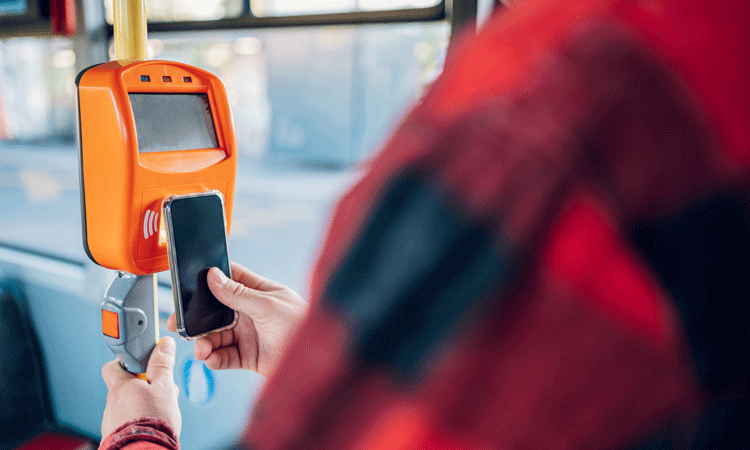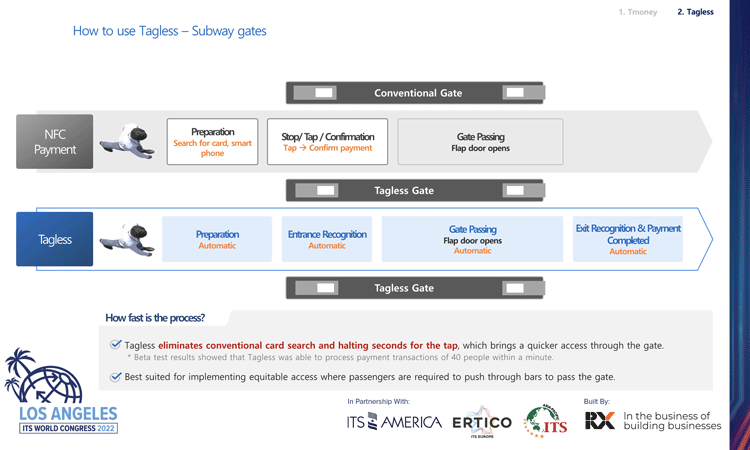The state of ticketing and payment technology: Current innovations and challenges
- Like
- Digg
- Del
- Tumblr
- VKontakte
- Buffer
- Love This
- Odnoklassniki
- Meneame
- Blogger
- Amazon
- Yahoo Mail
- Gmail
- AOL
- Newsvine
- HackerNews
- Evernote
- MySpace
- Mail.ru
- Viadeo
- Line
- Comments
- Yummly
- SMS
- Viber
- Telegram
- Subscribe
- Skype
- Facebook Messenger
- Kakao
- LiveJournal
- Yammer
- Edgar
- Fintel
- Mix
- Instapaper
- Copy Link
Posted: 1 September 2023 | Carol Schweiger - Schweiger Consulting | No comments yet
Intelligent Transport Advisory Board member, Carol Schweiger, discusses the benefits and challenges of implementing new payment technologies in public transport systems, such as mobile fare payment and contactless payment readers, while highlighting the importance of ensuring that these technologies are user-friendly and accessible to all passengers, including those who may not have access to a smartphone or bank account. In addition, she weighs both the positives and negatives of the industry becoming fare-free, and considers what the future may look like in this space.


The contribution of technology to public transport ticketing and payments has been significant over the past several years around the world”
The contribution of technology to public transport ticketing and payments has been significant over the past several years around the world. In the U.S., many public transport systems have and are moving toward mobile fare payment. One of the more prominent fare system technologies has been developed by the California Integrated Travel Project (Cal-ITP). “Adding a contactless payment reader to a bus or train means customers can quickly and easily tap to pay as they board with the bank card or smartphone that’s already in their pocket – just like they’d tap to buy a coffee. Starting with Monterey-Salinas Transit [in Monterey, California], Cal-ITP and partners like Visa are demonstrating how a transit provider that has traditionally used cash and agency-specific fare cards can accept contactless bank card payments like any other merchant.” Furthermore, Cal-ITP is working toward rolling out this open technology across the U.S..
Technological innovations in ticketing and payments across the globe
Another example of advancements in ticketing and payment technology is a ‘tagless’ subway payment gate which does not require a farecard tap. This new technology was tested in two subway stations in Seoul, South Korea. Figure 1 illustrates this new technology in comparison to traditional farecard use1.
Another payment innovation to note is a Mobility Wallet (MW), which supports the concept of Universal Basic Mobility (UBM)2. “A Mobility Wallet is a token or tool that provides users with access to rides, passes, best fares and/or personalised credits. This token or tool can be utilised by riders to make trip payment easier and more seamless across a range of mobility options, modes and carriers.” A MW for travellers can be developed with credits that can be spent for paying public transport fares and road usage fees, or to finance trips with alternative modes. Travellers are incentivised to use alternative modes (other than private vehicles), with credits being added to their wallet when doing so. For disadvantaged users, the MW can be partially or wholly subsidised.
The MW pilot programme that is being conducted by the Los Angeles Department of Transportation (LA DOT) and LA County Metropolitan Transportation Authority (LA Metro), as part of the South Los Angeles UBM Pilot Program, will have 5,000 participants – 1,500 from the Low-Income Fare is Easy (LIFE) programme, 1,500 from local Community Colleges and 2,000 new LA residents. Free mobile phones will be provided for up to 20% of the new resident participants. Phase I of this MW Pilot has already started as of March 2023, while the South LA UBM Pilot Program will run through to March 2025.


Figure 1: An infographic outlining how ‘tagless’ subway gates can be used.
Exploring the possibility of fare elimination in a post-pandemic world
Tangential to fare payment technology is the discussion about eliminating fare payment in public transport. During the COVID-19 pandemic, fare collection was suspended by several public transport agencies on buses across the U.S., particularly those agencies that did not have automated or mobile fare payment at the time. This action was to limit any close contact between bus drivers and passengers. This prompted two actions:
- Agencies procuring and implementing mobile fare payment systems to reduce or eliminate cash transactions
- Agencies declaring that they would eliminate fares for the foreseeable future.
The latter approach was fuelled in the U.S. by the $25 billion (provided by the Coronavirus Aid, Relief and Economic Security [CARES] Act) directed to public transit agencies “to support capital, operating and other expenses generally eligible under those programmes to prevent, prepare for, and respond to COVID-19.”
As a result, now more than ever, there are numerous fare-free pilot programmes that are being conducted in the U.S., despite the fact that some public transport agencies outside of the country had already decided to operate fare-free in the last few years (e.g., Luxembourg, Malta, Tallinn and Estonia).
This fare-free movement has been publicised extensively in the U.S. and has become a favourable action to address several issues, including equity. Merrimack Valley Transit Authority in Massachusetts, which went fare‑free for two years starting on 1 March 2022, had used videos and photos showing fareboxes being removed from buses to promote the elimination of fares. A few other agencies in Massachusetts that are temporarily staying fare-free include the Worcester Regional Transit Authority in Worcester and several bus routes operated in Boston by the Massachusetts Bay Transportation Authority (MBTA).
Pros and cons of fare elimination
In 2021, I wrote an article for Intelligent Transport entitled ‘Does eliminating fares make public transport more equitable?’ In that article, I had outlined the pros and cons of not charging fares for public transport. While I maintain that those pros and cons are still valid, there is new evidence that eliminating fares can result in an increase in ridership and reduction in air pollution, but not as much as originally thought.
If public transport does not go where and when people need to travel, it does not matter if it is free or not”
Furthermore, eliminating fares can result in negative effects, such as crowding. When instituted in a system that has multiple modes, if only one mode (e.g., bus) is free, anyone who must transfer to another mode to complete their trip does not save as much money as they would if they were only riding a fare-free bus.
Finally, when the CARES Act funding is exhausted, many of these fare-free programmes are likely to be in jeopardy. This ‘fiscal cliff’ will not only impact decisions about funding and maintaining a fare-free system, but also capital funding, which supports technology system (e.g., mobile fare payment) deployments.
In any case, perhaps the most important point in the fare-free debate is that “fare-free service does not replace good transit service3.” If public transport does not go where and when people need to travel, it does not matter if it is free or not. Other key points in the debate are:
- If special funding that is replacing fare revenue, such as the CARES Act funding, ends, what funding will replace it?
- If the increase in ridership as a result of eliminating fares causes crowding and operational reliability issues, what funding will be necessary to procure new vehicles and provide a more frequent service?
Current fare payment initiatives and future challenges
The price of fare collection and management technology is considerably lower than it has been in the past and it has the capability to manage complex fare programmes, including targeted reduced fare programmes to better serve specific traveller groups (e.g., low-income individuals, persons with disabilities and the elderly).
Another fare-related initiative that has been implemented in several locations is providing lower fares to address equity, climate change and affordability. With inflation rising in the last few years, several public transport systems have provided reduced flat fares, such as the €9 public transport ticket ($9.56) a month for all subways, buses, trams and regional trains in Germany from 1 June through to 31 August 2022; and the £2 cap on bus fares in England, which has recently been extended to 30 June 2023. These low fare programmes were funded in part by special government support provided during the pandemic – similar to the situation in the U.S.. So, these programmes will face a similar fiscal cliff if special funding ends. In England, “up to 15% of services could be scrapped, according to the Confederation of Passenger Transport, which represents bus and coach firms4.”
Fortunately, in Germany, the proposed €49 ($52) a month public transport ticket to be introduced on 1 May 2023 has (as of this writing) been approved in the Bundestag. The final approval had moved to the Bundesrat for a vote at the end of March 2023. In terms of financing this flat fare, “the federal government will spend €1.5 billion [$1.6 billion] annually in the years 2023-2025. Beyond that, it will cover half the cost of introducing the scheme over the course of this year. Financing beyond 2025 is to be dealt with later5.”
Also, in England, “the cities of Manchester, Liverpool and West Yorkshire have already introduced £2 caps as part of longer-term schemes6.”
References
- Kyle Lee, Presentation in Session SIS22, 2022 ITS World Congress, Los Angeles, CA, September 18, 2022
- Universal Basic Mobility (UBM) is the concept of providing a foundational level of mobility to all members of society, regardless of factors such as geographic location or income level, through partnerships and policies. See: https://itsa.org/wp-content/uploads/2022/03/Universal-Basic-Mobility-One-Pager_Final.pdf
- Taylor Dolven and Ashley Soebroto, “Study says more people are saving money, riding the bus after one year of Boston’s fare-free program,” The Boston Globe, Updated March 14, 2023, https://www.bostonglobe.com/2023/03/14/metro/study-says-more-people-are-saving-money-riding-bus-after-one-year-bostons-fare-free-program/
- Hope Bolger, “Warning hundreds of England bus services face cuts,” BBC News, 7 February 2023, https://www.bbc.com/news/business-64557250
- “Germany’s €49 transport ticket gets green light in Bundestag,” Deutsche Welle, March 16, 2023, https://www.dw.com/en/germanys-49-public-transport-ticket-one-step-closer-after-bundestag-green-light/a-65019086
- Faarea Masud, “Bus £2 fare cap extended for three months,” BBC News, 17 February 2023, https://www.bbc.com/news/business-64678990


Related topics
Multimodality, Passenger Experience, Public Transport, Ticketing & Payments
Issue
Issue 2 2023
Related modes
Bus & Coach, Light Rail, Train, Tram
Related cities
California, Liverpool, Los Angeles, Manchester, Seoul, West Yorkshire
Related countries
Estonia, Germany, Luxembourg, Malta, South Korea, United Kingdom, United States
Related organisations
Schweiger Consulting LLC
Related people
Carol Schweiger







